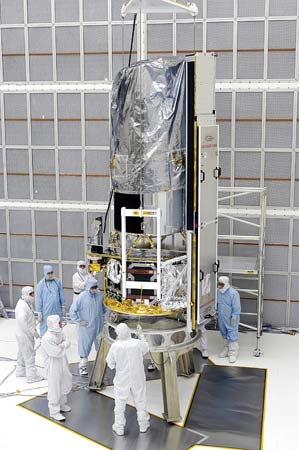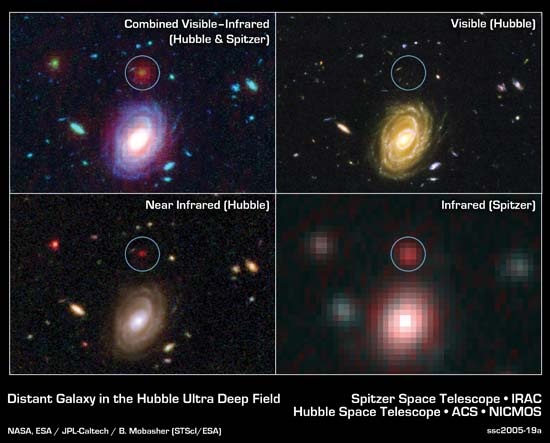Spitzer Space Telescope
United States satellite
 U.S. satellite, the fourth and last of the National Aeronautics and Space Administration fleet of “Great Observatories” satellites, designed to study the Cosmos at infrared (infrared radiation) wavelengths. In operation since 2003, the Spitzer observatory is expected to spend at least six years gathering information on the origin, evolution, and composition of planets and smaller bodies, stars, galaxies, and the universe as a whole. It was named in honour of Lyman Spitzer, Jr. (Spitzer, Lyman, Jr.), an American astrophysicist who in a seminal 1946 paper foresaw the power of astronomical telescopes (telescope) operating in space.
U.S. satellite, the fourth and last of the National Aeronautics and Space Administration fleet of “Great Observatories” satellites, designed to study the Cosmos at infrared (infrared radiation) wavelengths. In operation since 2003, the Spitzer observatory is expected to spend at least six years gathering information on the origin, evolution, and composition of planets and smaller bodies, stars, galaxies, and the universe as a whole. It was named in honour of Lyman Spitzer, Jr. (Spitzer, Lyman, Jr.), an American astrophysicist who in a seminal 1946 paper foresaw the power of astronomical telescopes (telescope) operating in space.The Spitzer observatory was launched on Aug. 25, 2003, by a Delta II rocket. To remove the spacecraft from Earth's thermal radiation effects, it was placed into a heliocentric, or solar, orbit with a period of revolution that causes it to drift away from Earth at a rate of 0.1 astronomical unit (15 million km, or 10 million miles) per year. This orbit differs radically from the low Earth orbits used by Spitzer's sister Great Observatories, the Hubble Space Telescope, the Compton Gamma Ray Observatory, and the Chandra X-ray Observatory. The satellite is a little over 4 metres (13 feet) tall and weighs about 900 kg (2,000 pounds). It is built around an all- beryllium 85-cm (33-inch) primary mirror that focuses infrared light on three instruments—a general-purpose near-infrared camera, a spectrograph sensitive to mid-infrared wavelengths, and an imaging photometer taking measurements in three far-infrared bands. Together the instruments cover a wavelength range of 3 to 180 micrometres. These instruments exceed those flown in previous infrared space observatories by using as their detectors large-format arrays with tens of thousands of pixels.
To reduce interference caused by thermal radiation from the environment and from their own components, infrared space observatories require cryogenic cooling, typically to temperatures as low as 5 K (−268 °C, or −450 °F). Spitzer's solar orbit simplifies the satellite's cryogenic system by taking it away from the heat of Earth. Much of the satellite's own heat is radiated into the cold vacuum of space, so that only a small amount of precious liquid helium cryogen is needed to maintain the telescope at its operating temperature of 5–15 K (−268 to −258 °C, or −450 to −432 °F).
The most striking results from Spitzer's observations concern extrasolar planets (extrasolar planet). Since the central stars (star) around which these planets revolve heat the planets to some 1,000 K (700 °C, or 1,300 °F), the planets themselves produce enough infrared radiation that Spitzer can easily detect them. Spitzer has determined the temperature and the atmospheric structure, composition, and dynamics of several extrasolar planets.
 Spitzer has also detected infrared radiation from sources so far away that in effect it has looked almost 13 billion years back in time to when the universe was less than 1 billion years old. Spitzer has shown that even at this early epoch some galaxies (galaxy) had already grown to the size of present-day galaxies and that they must have formed within a few hundred million years of the big bang (big-bang model) that gave birth to the universe some 13.7 billion years ago. Such observations can provide stringent tests of theories of the origin and growth of structure in the evolving universe.
Spitzer has also detected infrared radiation from sources so far away that in effect it has looked almost 13 billion years back in time to when the universe was less than 1 billion years old. Spitzer has shown that even at this early epoch some galaxies (galaxy) had already grown to the size of present-day galaxies and that they must have formed within a few hundred million years of the big bang (big-bang model) that gave birth to the universe some 13.7 billion years ago. Such observations can provide stringent tests of theories of the origin and growth of structure in the evolving universe.Astronomers will continue to use all of Spitzer's capabilities until about May 2009, when the liquid helium cryogen will be depleted. Even without the helium, however, Spitzer's unique thermal design and its solar orbit will ensure that the telescope and instruments reach a new equilibrium at a temperature of only 30 K (−243 °C, or −405 °F). At this temperature, Spitzer's shortest-wavelength-detector arrays should continue to operate without any loss of sensitivity. Spitzer's 5.5-year cryogenic mission will thus be followed by a “warm Spitzer” mission that will continue until the satellite is expected to move out of convenient communication range in 2014.
- Dostoyevsky, Fyodor
- Dosítheos
- Dothan
- Dotremont, Christian
- dotterel
- Dottore
- dou
- Douai
- Douai-Reims Bible
- Douala
- Douarnenez
- double bass
- double dactyls
- Doubleday, Abner
- Doubleday, Frank Nelson
- double jeopardy
- double refraction
- doublet
- double vision
- Doubs River
- douc
- Doudart de Lagrée, Ernest-Marc-Louis
- Dou, Gerrit
- dough
- Doughty, Charles Montagu